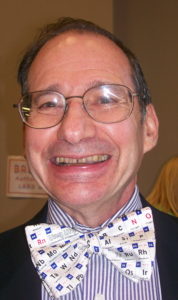

Note: All materials on this site are the copyrighted property of Alfred B. Bortz. Individuals may print single copies of reviews or columns for their own use. For permission to publish or print multiple copies of any of the materials on this site, please contact the author by e-mail.
 A Most Improbable Journey: A Big History of Our Planet and Ourselves by Walter Alvarez. Geologist Alvarez and his father, Nobel Laureate physicist Luis Alvarez, along with nuclear chemists Frank Asaro and Helen Michel*, transformed our knowledge of the mass extinction by discovering that an asteroid impact was the likely cause of the demise of the dinosaurs and many other species at the end of the Cretaceous period. He wrote about that literally Earth-shaking event earlier in T-Rex and the Crater of Doom.
A Most Improbable Journey: A Big History of Our Planet and Ourselves by Walter Alvarez. Geologist Alvarez and his father, Nobel Laureate physicist Luis Alvarez, along with nuclear chemists Frank Asaro and Helen Michel*, transformed our knowledge of the mass extinction by discovering that an asteroid impact was the likely cause of the demise of the dinosaurs and many other species at the end of the Cretaceous period. He wrote about that literally Earth-shaking event earlier in T-Rex and the Crater of Doom.
 Earth in Human Hands: Shaping Our Planet's Future by David Grinspoon. Grinspoon is an Astrobiologist whose scholarship and quirky personality shine through in his writing. I had the pleasure of hearing him speak about the new geological epoch that we humans have imposed on our planet, the Anthropocene.
Earth in Human Hands: Shaping Our Planet's Future by David Grinspoon. Grinspoon is an Astrobiologist whose scholarship and quirky personality shine through in his writing. I had the pleasure of hearing him speak about the new geological epoch that we humans have imposed on our planet, the Anthropocene.
 A Most Elegant Equation: Euler's Formula and the Beauty of Mathematics by David Stipp. I remember my own astonishment when I first encountered the equation that combines the base of natural logarithms known as e, the square root of -1 or i, and the remarkable and well known constant pi in one compact equation that reads "e to the i pi plus 1 equals zero." It takes at least one book to fully grasp the implications of that formula, and Stipp's is a good place to start.
A Most Elegant Equation: Euler's Formula and the Beauty of Mathematics by David Stipp. I remember my own astonishment when I first encountered the equation that combines the base of natural logarithms known as e, the square root of -1 or i, and the remarkable and well known constant pi in one compact equation that reads "e to the i pi plus 1 equals zero." It takes at least one book to fully grasp the implications of that formula, and Stipp's is a good place to start.
 Designing Reality: How to Survive and Thrive in the Third Digital Revolution by Neil Gershenfeld, Alan Gershenfeld, and Joel Cutcher-Gershenfeld. As the publisher notes, "Two digital revolutions--computing and communication--have radically transformed our economy and lives. A third digital revolution is here: fabrication. Today's 3D printers are only the start of a trend, accelerating exponentially, to turn data into objects: Neil Gershenfeld and his collaborators ultimately aim to create a universal replicator straight out of Star Trek. While digital fabrication promises us self-sufficient cities and the ability to make (almost) anything, it could also lead to massive inequality. The first two digital revolutions caught most of the world flat-footed, thanks to Designing Reality that won't be true this time."
Designing Reality: How to Survive and Thrive in the Third Digital Revolution by Neil Gershenfeld, Alan Gershenfeld, and Joel Cutcher-Gershenfeld. As the publisher notes, "Two digital revolutions--computing and communication--have radically transformed our economy and lives. A third digital revolution is here: fabrication. Today's 3D printers are only the start of a trend, accelerating exponentially, to turn data into objects: Neil Gershenfeld and his collaborators ultimately aim to create a universal replicator straight out of Star Trek. While digital fabrication promises us self-sufficient cities and the ability to make (almost) anything, it could also lead to massive inequality. The first two digital revolutions caught most of the world flat-footed, thanks to Designing Reality that won't be true this time."